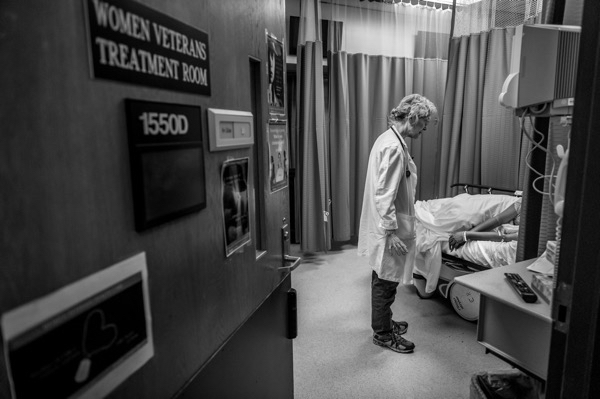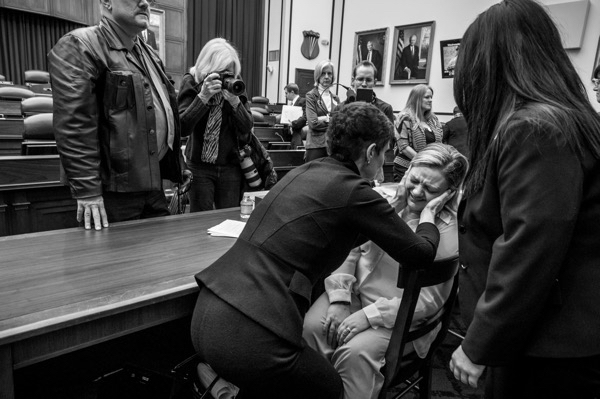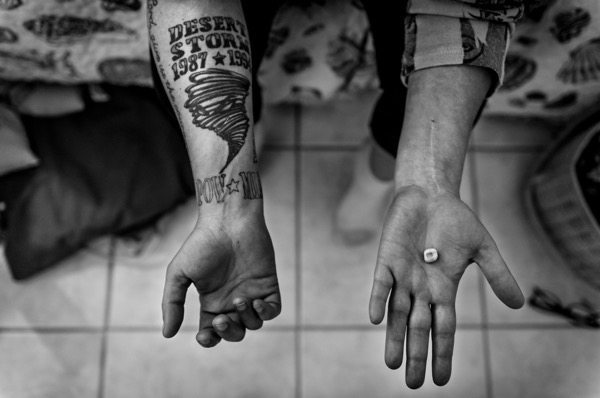Notes
World Press Photo Winners: Mary F. Calvert and Military Sexual Assault

I wanted to focus on Mary Calvert’s photo project involving women raped or sexually assaulted while serving in the U.S. military. It won first place for long term projects at World Press.
Of the thirty or so photos in the World Press entry, I was naturally interested in the more political images. Take the picture above, for example. The caption reads:
Dr. Nancy Lutwak, Veteran’s Administration emergency room physician in New York City, began screening patients for military sexual assault and opened up a room just for female veterans so they could have a safe place to reveal their military sexual trauma and then receive the health care and counseling they require.
If it was quite an achievement to actually create a dedicated treatment space inside the military establishment, ongoing abuse makes the existance of the photo, and now its wider circulation and recognition an achievement also. It opens the door that much wider. I’m also interested in the sematics of the sign, “Woman Veterans Treatment Room.” Of course, a generic label provides for discretion against the stigma of abuse. In this instance, though, it strikes me as one more instance of guardedness — treating sexual abuse and trauma as there but not there.
I was also interested in two photos from U.S. Senate hearings on military sexual misconduct. It’s not that there hasn’t been photo coverage of these hearings in the traditional media, by the way. The wire photos in this post we did in March 2013, for example, were quite thoughtful.

From the longer angle, and in stark black-and-white, however, Calvert offers a troubling perspective. Here’s the caption:
TSgt Jennifer Norris was drugged and raped by her recruiter after joining the US Air Force when she was 21 years old. She testified on Capitol Hill before the sparsely attended House Armed Services Committee hearing to discuss sexual misconduct by basic training instructors at Lackland Air Force Base in San Antonio, Texas. Taken in Washington, D.C.
The key work here, of course, is “sparsely”, the near-absence of lawmakers punctuated by all those notepads. The other element Calvert targets is the hallowed portrait gallery of former legislators, this ring of men encircling the live feed of the meeting, the context engendering a pompous air. If the empty chairs highlight institutional neglect, the portraits speak to a different legacy — specifically, how many service women (and men) were abused under these famed watches.

Finally, look at Calvert’s composition of this very emotional image. The caption reads:
TSgt Jennifer Norris is comforted by Nancy Parrish, President, Protect Our Defenders, after testifying before the sparsely attended House Armed Services Committee hearing on Capitol Hill, to discuss sexual misconduct by basic training instructors at Lackland Air Force Base in San Antonio, Texas. Taken in Washington, D.C.
Shifted right, we’d be more singularly focused on Ms. Sherman and the abhorrent experience detailed above. But we’re not. What the photo shares instead — with the added irony of a female photographer on top of people just standing and watching (or oblivious) — is how going public and bringing this crisis to public and institutional awareness contains its own trauma, and abuse.

Finally, what a stunning portrait, and such a simple and powerful way to employ the rhetoric of “on one hand, and on the other.” The caption states:
Connie Sue Foss was raped three times during her seven-year military career and has found it difficult to hold down a job to care for herself and her daughter. She bears scars from punching a window during a PTSD episode and holds a molar she lost from grinding her teeth at night.
What we have as much or more than a weighing, though, is cause-and-effect. Reading left-to-right the way we do, what we see is the outcome of Connie’s patriotism. And her own identification as a prisoner of war and someone missing in action (as she’s missing in the photo). And, as fast as it is to go to war, what we also see is the scarred and grinding unravelling of the tornado.
Correction: February 29, 2016. The caption on the third photograph was updated for accuracy.
(photos: Mary F. Calvert – ZumaPress / Alexia Foundation)


Reactions
Comments Powered by Disqus